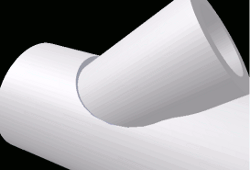 An important feature that needs mentioning here is Cut Optimization. Let us look at an example to show the problem. In an 'On Inside Wall' joint construction of a simple Branch Joint, the branch pipe enters the side wall of the header pipe. If the header pipe bevel type is set to 'Perpendicular Cut' and the branch pipe is set to "Bevel Cut", the hole in the header is elongated to allow the branch to pass through the header's wall. This header cut line would be the same as if the branch pipe went all the way through the surface of the header.
An important feature that needs mentioning here is Cut Optimization. Let us look at an example to show the problem. In an 'On Inside Wall' joint construction of a simple Branch Joint, the branch pipe enters the side wall of the header pipe. If the header pipe bevel type is set to 'Perpendicular Cut' and the branch pipe is set to "Bevel Cut", the hole in the header is elongated to allow the branch to pass through the header's wall. This header cut line would be the same as if the branch pipe went all the way through the surface of the header.
 Now if the branch pipe is set to 'Perpendicular Cut' and 'On Inside Wall', its end is cut perpendicularly so that it does not intrude into the interior of the header pipe. This would result in a gap between the end of the branch pipe and the elongated hole in the header pipe. To solve this Digital Pipe Fitter automatically adjusts the size of the header hole to come in contact with the end of the branch pipe all the way around the joint. This optimization includes the cases where either pipe has a thicker wall thickness than the other. The result is that there will never be a gap in a joint created by Digital Pipe Fitter if the specified component is long enough to complete the joint.
Now if the branch pipe is set to 'Perpendicular Cut' and 'On Inside Wall', its end is cut perpendicularly so that it does not intrude into the interior of the header pipe. This would result in a gap between the end of the branch pipe and the elongated hole in the header pipe. To solve this Digital Pipe Fitter automatically adjusts the size of the header hole to come in contact with the end of the branch pipe all the way around the joint. This optimization includes the cases where either pipe has a thicker wall thickness than the other. The result is that there will never be a gap in a joint created by Digital Pipe Fitter if the specified component is long enough to complete the joint.
Optimization is normally only needed when both components have bevel constructions set to ‘Perpendicular Cut' and the joint construction is ‘On Inside Wall' or ‘On Far Outside Wall'.
